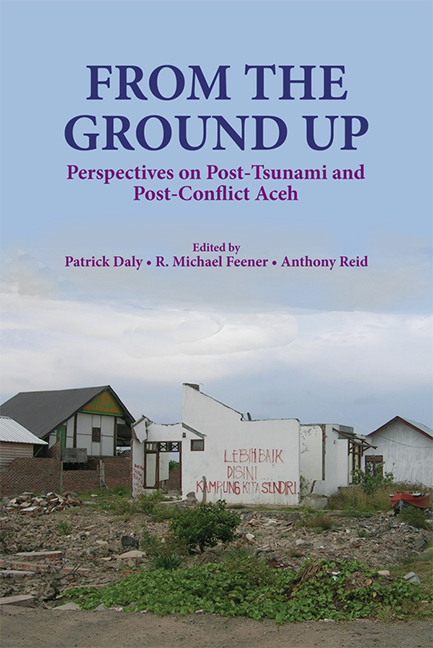Book contents
- Frontmatter
- Contents
- Preface
- List of Figures and Tables
- The Contributors
- Glossary and Abbreviations
- Introduction: Unpacking the Challenges of Post-2004 Aceh
- 1 The Sunda Megathrust: Past, Present and Future
- Part I Reconstruction Efforts
- Part II Conflict Resolution
- 9 Managing Risk: Aceh, the Helsinki Accords and Indonesia's Democratic Development
- 10 Making Peace Agreements Effective: The Aceh Monitoring Mission Experience
- 11 Justice and the Aceh Peace Process
- 12 Managing Peace in Aceh: The Challenge of Post-Conflict Peace Building
- Index
10 - Making Peace Agreements Effective: The Aceh Monitoring Mission Experience
from Part II - Conflict Resolution
Published online by Cambridge University Press: 21 October 2015
- Frontmatter
- Contents
- Preface
- List of Figures and Tables
- The Contributors
- Glossary and Abbreviations
- Introduction: Unpacking the Challenges of Post-2004 Aceh
- 1 The Sunda Megathrust: Past, Present and Future
- Part I Reconstruction Efforts
- Part II Conflict Resolution
- 9 Managing Risk: Aceh, the Helsinki Accords and Indonesia's Democratic Development
- 10 Making Peace Agreements Effective: The Aceh Monitoring Mission Experience
- 11 Justice and the Aceh Peace Process
- 12 Managing Peace in Aceh: The Challenge of Post-Conflict Peace Building
- Index
Summary
INTRODUCTION
The people of Aceh have been the victims of two immense disasters: more than three decades of conflict that officially ended in 2006 and the 2004 tsunami. Both of these have been at the centre of immense international focus since the tsunami propelled Aceh onto the world stage; the peace process and the post-tsunami relief and reconstruction efforts have involved significant amounts of international intervention. Both are important examples that need to be better understood, as they can provide valuable lessons for other conflict and post-disaster situations in the region and beyond.
In this chapter, I provide a brief assessment of the workings of the peace process from the perspective of the Aceh Monitoring Mission (AMM), which I had the honour of heading from 2005 until 2006. The AMM was put in place as part of efforts to ensure that both GAM and the Indonesian Government operated in good faith on the obligations agreed to in the Helsinki Memorandum of Understanding, signed on 15 August 2005. I explore the experiences of the AMM and discuss why the peace process has so far been relatively successful. Following this, I will talk about the wider implications this process has for Indonesia and the region, and about the importance of peace in the reconstruction and development of Aceh. Finally, I conclude by discussing some matters that might be factors in the future.
POLITICAL FACTORS FOR THE PEACEFUL SOLUTION: FOUR KEY REASONS
While the cessation of hostilities in Aceh, like all peace processes, was an incredibly complicated process that required the sincere efforts of multiple parties to resolve, there are four key reasons for its success that I want emphasize. These points are crucial elements without which the peace process would not have succeeded.
First, the MoU signed in Helsinki was very well constructed. Not only did it address the main concerns of both parties, but it also benefited from clearly articulated sets of provisions, responsibilities, and timelines.
- Type
- Chapter
- Information
- From the Ground UpPerspectives on Post-Tsunami and Post-Conflict Aceh, pp. 214 - 224Publisher: ISEAS–Yusof Ishak InstitutePrint publication year: 2012



